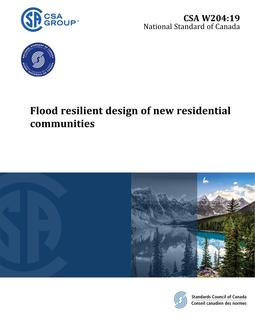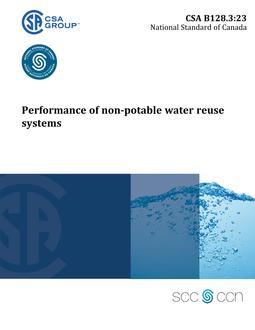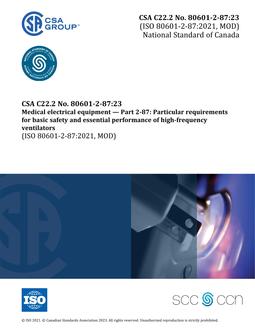
CSA W204:19
Click here to purchase
Preface:
This is the first edition of CSA W204, Flood resilient design of new residential communities.
It should be noted that this Standard, by itself, does not have the force of law unless it is officially adopted by a regulatory authority. Since regulatory authorities can adopt the Standard with certain exceptions or additional requirements, the regulatory authority of the relevant jurisdiction should be consulted in order to establish the extent to which this Standard has been adopted.
Where this Standard conflicts with regulatory requirements, the regulatory requirements take precedence.
CSA Group acknowledges that the development of this Standard was made possible, in part, by the financial support of Standards Council of Canada, as part of the Standards to Support Resilience in Infrastructure Program.
This Standard has been developed in compliance with Standards Council of Canada requirements for National Standards of Canada. It has been published as a National Standard of Canada by CSA Group.
Scope:
1.1 Inclusions of the Standard
1.1.1 Purpose of this Standard
The purpose of this Standard is to provide compliance criteria and guidance on the design of flood- resilient new residential communities as it relates to greenfield development only.
1.1.2 Building types
This Standard is applicable to the following building types:
a) detached homes;
b) semi-detached homes;
c) row houses (including stacked and back-to-back townhomes); and
d) mixed-use residential development (residential, small commercial, and institutional use).
Note: Garages (attached and detached) and non-habitable accessory buildings (e.g., porches, gazebos) located on the residential lots are considered within the scope of this Standard.
1.1.3 Design elements
This Standard covers the following considerations:
a) design for resilience to address extreme weather events and operational uncertainties;
b) storm sewer system design (minor drainage system considerations);
c) street design (major overland drainage system considerations);
d) sanitary sewer design (wastewater drainage system considerations);
e) wastewater pumping station design; and
f) considerations for preservation of natural infrastructure and low impact development measures.
1.1.4 Flood hazards
The types of flood hazards considered by this Standard include
a) riverine flooding;
b) overland flooding;
c) storm and sanitary sewer surcharge;
d) drainage system failures (e.g., inlet, ice, and debris blockages); and
e) groundwater seepage.
1.2 Exclusions of the Standard
1.2.1 Other types of development
This Standard does not cover flood resilience considerations as they relate to existing development, infill, intensification, or redevelopment.
1.2.2 Types of flood hazards
Types of flood hazards that are outside the scope of this Standard include
a) sea level rise;
b) storm surges;
c) unique flood hazards (e.g., dam failures); and
d) flood risk specific to alluvial fans.
1.2.3 Geographic limitations
This Standard includes requirements and recommendations expected to be relevant across Canada. Its application could be insufficient in the areas with permafrost, such as Yukon, Northwest Territories, and Nunavut, as well as in areas subject to coastal and lake flooding, where sea level rise and storm surges pose additional flood risk that is not addressed by the Standard.
1.3 Requirements of local jurisdictions
This Standard provides requirements and recommendations for the design of flood-resilient greenfield community developments. In the application of this Standard, it should be noted that local jurisdictions might have criteria or requirements beyond what is provided in this Standard. The intent of this Standard is to provide minimum acceptable criteria. In the event that a local jurisdiction requirement is more stringent than that required by this Standard, the more stringent requirement takes precedence over the requirement stipulated in this Standard. It is the responsibility of the user of this Standard to be aware of any discrepancies and to determine the manner in which it can be resolved.
1.4 Climate uncertainty considerations
This Standard provides a dynamic approach to the design of flood-resilient new residential communities. This includes the use of data that anticipates future climate changes, including changes in the frequency of extreme rainfall events. Such data is currently the subject of intense research but is not yet available with adequate confidence. In the absence of such predictive climate data, the users of this Standard should consider applying appropriate adjustments to current intensity-duration-frequency (IDF) values to account for climate uncertainties. For information on the use and interpretation of IDF information, see CSA PLUS 4013:2019.
1.5 Terminology
In this Standard, “shall” is used to express a requirement, i.e., a provision that the user is obliged to satisfy in order to comply with the Standard; “should” is used to express a recommendation or that which is advised but not required; and “may” is used to express an option or that which is permissible within the limits of the Standard. Notes accompanying clauses do not include requirements or alternative requirements; the purpose of a note accompanying a clause is to separate from the text explanatory or informative material. Notes to tables and figures are considered part of the table or figure and may be written as requirements. Annexes are designated normative (mandatory) or informative (non-mandatory) to define their application.
Product Details
- Edition:
- 1st
- Published:
- 12/01/2019
- ISBN(s):
- 9781488326110
- Number of Pages:
- 70
- File Size:
- 1 file , 2 MB
- Product Code(s):
- 2427685, 2427738, 2427685


